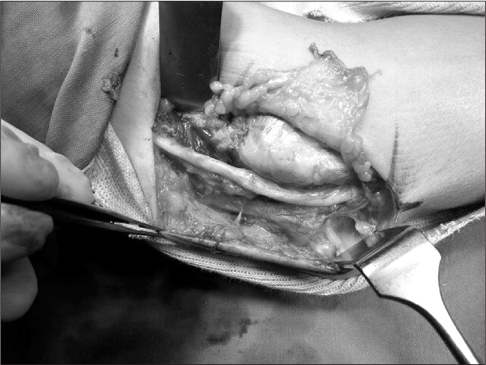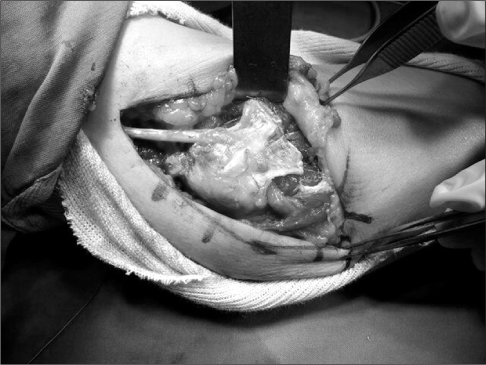J Korean Orthop Assoc.
2012 Oct;47(5):382-386. 10.4055/jkoa.2012.47.5.382.
A Fusiform Epineural Ganglion Encompassing the Ulnar Nerve in the Cubital Tunnel
- Affiliations
-
- 1Department of Orthopedic Surgery, Chungnam National University School of Medicine, Daejeon, Korea. hyunsd@cnu.ac.kr
- KMID: 2185323
- DOI: http://doi.org/10.4055/jkoa.2012.47.5.382
Abstract
- Cubital tunnel syndrome, caused by a ganglion, is rare and most ganglion cysts originate from the medial aspect of the ulnohumeral joint. We present an extremely rare case of a fusiform epineural ganglion, encompassing the ulnar nerve in the cubital tunnel. A 48-year-old man complained of a 6-month history of typical cubital tunnel syndrome symptoms. Electrophysiological studies were compatible with the compressive neuropathy of the ulnar nerve. A fusiform epineural ganglion cyst (1.4 cm in diameter and 7.2 cm in length), which encompasses the ulnar nerve in the cubital tunnel, was found with no connection to the elbow joint. The ganglion cyst was excised and the ulnar nerve anterior transmuscular transposition was performed. Six months postoperatively, the patient was free of pain, tingling sensations, and numbness. In addition, his grip and pinch strength improved, the muscle wasting showed recovery, and an electrophysiological study demonstrated some improvement.
Keyword
MeSH Terms
Figure
Reference
-
1. Allieu PY, Cenac PE. Peripheral nerve mucoid degeneration of the upper extremity. J Hand Surg Am. 1989. 14:189–194.
Article2. Bowers WH, Doppelt SH. Compression of the deep branch of the ulnar nerve by an intraneural cyst. Case report. J Bone Joint Surg Am. 1979. 61:612–613.
Article3. Ferlic DC, Ries MD. Epineural ganglion of the ulnar nerve at the elbow. J Hand Surg Am. 1990. 15:996–998.
Article4. Gurdjian ES, Larsen RD, Lindner DW. Intraneural cyst of the peroneal and ulnar nerves. Report of two cases. J Neurosurg. 1965. 23:76–78.5. Hsu RW, Chen CY, Shen WJ. Ulnar nerve palsy due to concomitant compression by the anconeus epitrochlearis muscle and a ganglion cyst. Orthopedics. 2004. 27:227–228.
Article6. Kato H, Hirayama T, Minami A, Iwasaki N, Hirachi K. Cubital tunnel syndrome associated with medial elbow Ganglia and osteoarthritis of the elbow. J Bone Joint Surg Am. 2002. 84:1413–1419.
Article7. Boursinos LA, Dimitriou CG. Ulnar nerve compression in the cubital tunnel by an epineural ganglion: a case report. Hand (N Y). 2007. 2:12–15.
Article8. McDowell CL, Henceroth WD. Compression of the ulnar nerve in the hand by a ganglion. Report of a case. J Bone Joint Surg Am. 1977. 59:980.
Article9. Ming Chan K, Thompson S, Amirjani N, Satkunam L, Strohschein FJ, Lobay GL. Compression of the ulnar nerve at the elbow by an intraneural ganglion. J Clin Neurosci. 2003. 10:245–248.
Article10. O'Hara JJ, Stone JH. Ulnar nerve compression at the elbow caused by a prominent medial head of the triceps and an anconeus epitrochlearis muscle. J Hand Surg Br. 1996. 21:133–135.
- Full Text Links
- Actions
-
Cited
- CITED
-
- Close
- Share
- Similar articles
-
- Intraneural Ganglion of Ulnar Nerve in Proximal Forearm: Case Report
- Cubital Tunnel Syndrome by a Ganglion Cyst in an Amateur Tennis Player
- Cubital tunnel syndrome caused by an intraneural ganglion cyst treated with epineurectomy: a report of three cases
- Cubital tunnel syndrome associated with previous ganglion cyst excision in the elbow: a case report
- The Cubital Tunnel Syndrome with Medial Ganglion Cyst




